The B2B landscape is getting even more competitive by the day, and outbound sales strategies are evolving as we speak.
For example, traditional sales teams often spend countless hours manually researching leads, reaching out, sending emails, and making cold calls. What’s wrong with this picture? It’s labor intensive, time-consuming, and scalability of sales efforts is very limited.
Enter AI-powered Sales Development Representatives (SDRs), a gamechanger in the outbound sales industry.
What is an AI SDR?
AI SDRs are platforms that use the power of artificial intelligence to accelerate and improve sales development processes.
In simple terms, these tools handle the repetitive tasks traditionally carried out by human SDRs, such as lead qualification, outreach, and follow-ups. However, since AI SDRs can analyze more data, buyer intent signals, and historical interactions, they can do so much more on a larger scale. At the same time, they help filter out repetitive tasks so human SDRs can focus on high-value deals.
AI SDRs automate key aspects of outbound sales, such as:
- Lead scoring: AI can analyze various factors at scale (ex. website behavior, social media engagement, and firmographics) to determine the quality of leads much faster, more efficiently, and more accurately than human SDRs.
- Cold email sequences: AI tools can draft personalized emails (based on leads’ or prospects’ data) at scale and schedule them for optimal times (based on behavior) to ensure consistent and effective outreach.
- Follow-up automation: After initial contact, AI-powered systems automatically send follow-up emails based on prospect behavior and engagement patterns.
- Multichannel outreach: AI SDR tools engage leads via multiple channels, including email, phone, and LinkedIn, making the outreach process both scalable and personalized.
What do AI SDRs offer?
For companies looking to scale outbound sales efficiently, investing in AI lead generation tools is no longer optional—it’s essential. Platforms like AnyBiz empower sales teams to work smarter, not harder, by automating repetitive tasks while delivering insights that drive measurable results. For example:
- AI SDRs combine artificial intelligence, predictive analytics, and automation to streamline the prospecting process. Instead of relying on human intuition alone, these platforms analyze vast amounts of data to identify the most promising leads. As AI SDRs can understand buyer intent and engagement patterns, outbound sales teams can prioritize high-value prospects and allocate their efforts where it matters most.
- AI SDRs can automate outreach without sacrificing personalization. AI tools can craft tailored emails, schedule follow-ups, and even optimize the timing of each message to maximize engagement. This level of precision is unique to AI lead generation and allows sales teams to maintain consistent communication across large prospect lists.
- AI SDRs integrate seamlessly with CRMs and sales engagement platforms. This ensures that every interaction is logged and actionable insights are generated. This integration helps sales managers track performance metrics, monitor pipeline health, and continuously optimize campaigns based on real-time data.
How AI SDRs are transforming outbound sales
To give a clear illustration of how AI SDRs are creating waves in the outbound sales process, here’s a comparison between the traditional process and what AI SDRs do.
| Process | Traditional Outbound Sales Process | AI SDR |
| Lead qualification process and output | Manual lead qualification is based on gut instincts, limited data, and human experience. | AI lead generation involves analyzing large datasets to predict lead quality using behavior and engagement data. They can then prioritize high-value leads or hand them off to human SDRs. |
| Personalized outreach | Sales teams manually craft emails for each lead. Sometimes, this can lead to inconsistent personalization and slower outreach. | AI SDRs automatically create personalized messages for each lead based on data-driven insights, ensuring consistent personalization at scale. |
| Multichannel engagement | Relying on one channel (usually email or phone) for outreach, with limited ability to manage multiple touchpoints efficiently. | AI SDRs engage prospects across email, phone, and social media, managing all channels in one workflow to ensure timely and consistent communication. |
| Scalability and efficiency | To scale, companies need to hire more SDRs, which increases labor costs and complexity. | AI SDRs handle high volumes of outreach without additional headcount, allowing for more efficient scaling of outreach efforts. |
| Sales cycle and conversion rates | Sales cycles are prolonged due to manual follow-ups and delayed responses, with inconsistent follow-up timing. | AI SDRs automate follow-ups, track prospect journeys, and ensure timely communication, significantly speeding up the sales cycle and increasing conversion rates. |
The future of AI SDR tools in B2B sales
As businesses face growing pressure to generate high-quality leads and close deals faster, AI-powered SDR tools are becoming indispensable. These tools provide a smarter, more efficient way to prospect, qualify, and engage leads, all while saving time and resources.
AI SDRs are not just the future of sales. They’re already here, transforming how companies approach lead generation and outreach.
Ready to transform your lead generation process? Explore how AnyBiz’s AI SDR platform can help you scale your sales efforts and close more deals with AI-powered solutions.




